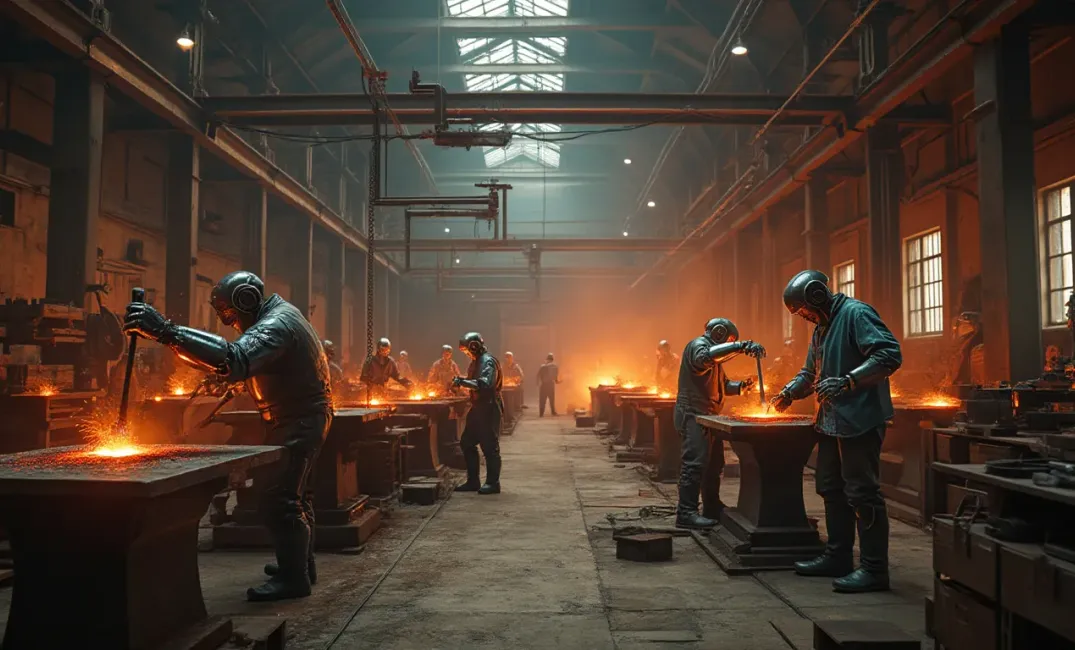Introduction: The Crucible of Progress and Innovation
Throughout history, the mastering of metals has been a transformative force, shaping societies and advancing civilizations. Metallurgy—the technique or science of working or heating metals to give them desired shapes or properties—has remained pivotal in driving technological innovation, from ancient swords and plowshares to modern skyscrapers and spacecraft. This entry explores the rich legacy of human metallurgy, showcasing its vital role in societal progress, cultural exchange, and the continuous archetype of innovation straddling art and science.
"Metals chart the story of civilization; with each sword shaped, plow struck, and monument erected, we trace the trajectory of mankind through the ring of an anvil and the curve of a wave." — Author Unknown
The Dawn of Metallurgy: From Stone to Metal
The Birth of Metalworking
- The Chalcolithic Age: Copper’s Initial Impact: As humanity transitioned from the Stone Age, the inception of copper usage marked a crucial breakthrough. Archaeological findings, such as those from the Middle East and Southeast Europe, highlight copper's usage for tools and ornaments, demonstrating early metallurgical experimentation.
- Bronze Age Revolution: The innovation of bronze, an alloy of copper and tin, propelled civilizations such as Mesopotamia, Egypt, and the Indus Valley into a new era of complex societies. Bronze facilitated the creation of stronger tools and weapons, fostering agricultural efficiency, increased trade, and territorial expansion.
Iron Ascent: Forging a New Age
- The Iron Age and Societal Transformation: Iron smelting, more challenging than copper and bronze, gradually superseded these metals due to its abundance and utility. The Hittites in Anatolia mastered ironwork, influencing technology dissemination across Europe, Asia, and Africa, fostering economic and cultural transformations.
- Symbolism and Ritual: Early metallurgical cultures often ascribed sacred significance to metals, with figures like the god Ptah in Egyptian mythology representing metalworking, forging symbols of divinity and power intertwined with technological advancement.
Metallurgy Across Cultures: A Tale of Innovation
Eastern Contributions: Meticulous Craft and Construction
- Chinese Metallurgy and Innovation: Ancient China witnessed significant metallurgical advancement with cast iron's development by the Han Dynasty. This innovation allowed the creation of plows, weapons, and architectural structures, demonstrating the intricate linkage between metallurgical mastery and societal development.
- Japan’s Artisan Legacy: Japanese swordsmithing, especially the forging of the katana, epitomizes artisanal craftsmanship combined with scientific precision. Techniques like folding steel to produce exceptionally resilient and sharp blades reflect meticulous attention to metallurgical artistry.
Western Experiences: Catalysts of Progress
- Ancient Greek and Roman Metallurgy: For the Greeks and Romans, iron and lead became integral, evident in armaments and infrastructural projects like aqueducts and buildings. The Coliseum and Roman army fortifications underscore the relationship between metal usage and imperial might.
- The European Renaissance and Alchemical Influence: The pursuit of alchemy, driven by Pliny the Elder and further embraced during the Renaissance, spurred experiments and curiosity in metallurgy. This era's burgeoning interest in transmuting metals laid foundations for modern chemistry.
Modern Metallurgical Marvels: Catalysts of Industrial Acceleration
The Industrial Age: Reinventing Civilization
- The Steel Revolution: The Bessemer process and open-hearth furnace marked the dawn of industrial steel production, reshaping infrastructures, railways, and bridges. This revolution facilitated unprecedented urban growth and industrialization during the 19th and 20th centuries, catalyzing global economic transformation.
- Aluminum and Lightweight Innovation: The discovery and refinement of aluminum brought advancements in transport, packaging, and aerospace industries, revolutionizing manufacturing practices and enhancing efficiency through lightweight, corrosion-resistant materials.
Metallurgy in Cultural Expressions
- Artistic Creations and Metallurgical Techniques: From the intricate filigree in jewelry to grandiose metallic sculptures, metal has been a versatile medium in art. Artists like Alexander Calder and Richard Serra expanded boundaries through metalwork's expressive potential, intertwining innovation with visual storytelling.
- Metallurgical Symbols in Literature and Myth: Throughout literature and myth, metals epitomize strength, resilience, and fortune. From the iron-wrought "gates of Hell" in Dante’s Inferno to Norse myths depicting Thor’s thunderous hammer of unyielding metal, metallurgy embodies timeless symbols across narratives.
Metallurgy’s Firmament: Technology and Sustainability
The Digital Age of Metallurgy
- Advanced Alloys and Nanotechnology: Today, research in creating superconducting or shape-memory alloys illustrates metallurgy’s enduring innovation, addressing challenges in electronics, medical devices, and engineering. These advances reveal metallurgy’s adaptability to contemporary scientific landscapes.
- Recycling and Sustainability Initiatives: Modern metallurgical practices embrace sustainability, recognizing metals' critical role in environmental responsibility. Initiatives focus on recycling scrap metals and reducing emissions in ore extraction, aiming for sustainable pathways in a resource-conscious world.
Challenges and Innovations Ahead
- Ethical Mining and Resource Management: The future of metallurgy depends on ethically extracting resources, balancing demand, and conserving biodiversity. Initiatives promoting fair labor, pollution control, and equitable resource distribution highlight ethical considerations in metallurgical endeavors.
- Integration of Artificial Intelligence: AI-driven metallurgy could revolutionize mining, refining, and alloy development, focusing on optimizing processes and mitigating environmental impacts. This intersection between AI and metallurgy exemplifies industrial evolution in conjunction with ethical stewardship.
The Future: Continual Evolution of Metallurgical Frontiers
Education and Metallurgical Innovation
- Integrative Learning and Expertise Cultivation: Educating future metallurgists requires interdisciplinary approaches, combining material sciences with computational prowess, creating adaptable problem-solvers capable of leading transformative advancements in metallurgical fields.
- Fostering Collaboration and Global Exchange: International collaborations, exemplified by global metallurgical conferences and knowledge-sharing platforms, foster innovation through cross-cultural perspectives, enabling diverse intellectual contributions to address shared challenges.
Metallurgy Beyond Earth: Cosmic Aspirations
- Extraterrestrial Resource Utilization: As humanity explores extraterrestrial terrains, metals from asteroids or lunar materials could play pivotal roles in space infrastructures. Understanding metallurgy’s role beyond Earth invites speculative engagements with cosmic resource potential.
- Pioneering Metallurgy for Space Colonization: Innovative metallurgical processes informed by microgravity experiments aboard space stations reflect ambitions to forge new worlds, symbolizing metallurgy’s hope-laden legacy in pursuing humanity’s cosmic endeavors.
Conclusion: Metallurgy as Civilization’s Forging Flame
Throughout time, human mastery of metallurgy embodies a legacy of innovation, resilience, and progress. As molds shape metals, metallurgy has shaped civilizations, permitting the construction of towering monuments, the crafting of cultural icons, and the transformation of technologies with enduring impacts on societal evolution.
As humanity navigates future challenges, the crucible of metallurgy remains a testament to creativity's limitless potential, inspiring ingenuity, sustainability, and cosmopolitanism in designing an interconnected world. By forging pathways with ethical consideration and collaborative spirit, humanity’s metallurgical journey kindles hope—a legacy forged in the flame of civilization.
"In the forge we find our future, where iron and dream intermingle, and the alchemy of tomorrow is cast anew from the fragments of today." — Author Unknown
COLLABORATION, SPACE EXPLORATION, CIVILIZATION, TECHNOLOGY, METALLURGY, HISTORY, ART, SUSTAINABILITY, CULTURE, INNOVATION

